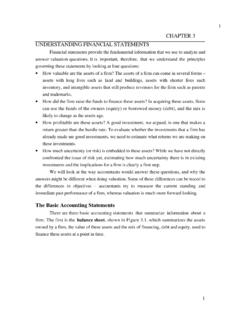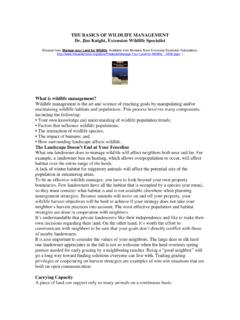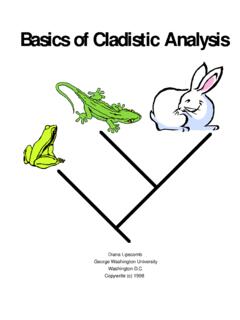Transcription of What Are the Basics of Bible Study? John MacArthur
1 What Are the Basics of Bible study ? john MacArthur Personal Bible study , in precept, is simple. I want to share with you 5 steps to Bible study which will give you a pattern to follow. STEP 1 Reading Read a passage of Scripture repeatedly until you understand its theme, meaning the main truth of the passage. Isaiah said, Whom will he teach knowledge? And whom will he make to understand the message? Those just weaned from milk? Those just drawn from the breasts? For precept must be upon precept, precept upon precept, line upon line, here a little, there a little (Is. 28:9,10). Develop a plan on how you will approach reading through the Bible . Unlike most books, you will probably not read it straight through from cover to cover. There are many good Bible reading plans available, but here is one that I have found helpful. Read through the Old Testament at least once a year. As you read, note in the margins any truths you particularly want to remember, and write down separately anything you do not immediately understand.
2 Often as you read you will find that many questions are answered by the text itself. The questions to which you cannot find answers become the starting points for more in-depth study using commentaries or other reference tools. Follow a different plan for reading the New Testament. Read one book at a time repetitiously for a month or more. This will help you to retain what is in the New Testament and not always have to depend on a concordance to find things. If you want to try this, begin with a short book, such as 1 john , and read it through in one sitting every day for 30 days. At the end of that time, you will know what is in the book. Write on index cards the major theme of each chapter. By referring to the cards as you do your daily reading, you will begin to remember the content of each chapter. In fact, you will develop a visual perception of the book in your mind. Divide longer books into short sections and read each section daily for 30 days. For example, the gospel of john contains 21 chapters.
3 Divide it into 3 sections of 7 chapters. At the end of 90 days, you will finish john . For variety, alternate short and long books, and in less than 3. years you will have finished the entire New Testament as you will really know it! STEP 2 Interpreting In Acts 8:30, Philip asked the Ethiopian eunuch, Do you understand what you are reading? . Or put another way, What does the Bible mean by what it says? It is not enough to read the text and jump directly to the application; we must first determine what it means, otherwise the application may be incorrect. 2. As you read Scripture, always keep in mind one simple question: What does this mean? To answer that question requires the use of the most basic principle of interpretation, called the analogy of faith, which tells the reader to interpret the Bible with the Bible . Letting the Holy Spirit be your teacher (1 john 2:27), search the Scripture He has authored, using cross references, comparative passages, concordances, indexes, and other helps.
4 For those passages that yet remain unclear, consult your pastor or godly men who have written in that particular area. Errors to Avoid As you interpret Scripture, several common errors should be avoided. 1. Do not draw any conclusions at the price of proper interpretation. That is, do not make the Bible say what you want it to say, but rather let it say what God intended when He wrote it. 2. Avoid superficial interpretation. You have heard people say, To me, this passage means, or I feel it is saying.. The first step in interpreting the Bible is to recognize the four gaps we have to bridge: language, culture, geography, and history (see below). 3. Do not spiritualize the passage. Interpret and understand the passage in its normal, literal, historical, grammatical sense, just like you would understand any other piece of literature you were reading today. Gaps to Bridge The books of the Bible were written many centuries ago. For us to understand today what God was communicating then, there are several gaps that need to be bridged: the language gap, the cultural gap, the geographical gap, and the historical gap.
5 Proper interpretation, therefore, takes time and disciplined effort. 1. Language. The Bible was originally written in Greek, Hebrew, and Aramaic. Often, understanding the meaning of a word or phrase in the original language can be the key to correctly interpreting a passage of Scripture. 2. Culture. The culture gap can be tricky. Some people try to use cultural differences to explain away the more difficult biblical commands. Realize that Scripture must first be viewed in the context of the culture in which it was written. Without an understanding of first-century Jewish culture, it is difficult to understand the gospel. Acts and the epistles must be read in light of the Greek and Roman cultures. 3. Geography. A third gap that needs to be closed is the geography gap. Biblical geography make the Bible come alive. A good Bible atlas is an invaluable reference tool that can help you comprehend the geography of the Holy Land. 4. History. We must also bridge the history gap. Unlike the scriptures of most other world religions, the Bible contains the records of actual historical persons and events.
6 An understanding of Bible history will help us place the people and events in it in their proper historical perspective. A good Bible dictionary or Bible encyclopedia is useful here, as are basic historical studies. 3. Principles to Understand Four principles should guide us as we interpret the Bible : literal, historical, grammatical, and synthesis. 1. The Literal Principle. Scripture should be understood in its literal, normal, and natural sense. While the Bible does contain figures of speech and symbols, they were intended to convey literal truth. In general, however, the Bible speaks in literal terms, and we must allow it to speak for itself. 2. The Historical Principle. This means that we interpret in its historical context. We must ask what the text meant to the people to whom it was first written. In this way we can develop a proper contextual understanding of the original intent of Scripture. 3. The Grammatical Principle. This requires that we understand the basic grammatical structure of each sentence in the original language.
7 To whom do the pronouns refer? What is the tense of the main verb? You will find that when you ask some simple questions like those, the meaning of the text immediately becomes clearer. 4. The Synthesis Principle. This is what the Reformers called the analogia scriptura. It means that the Bible does not contradict itself. If we arrive at an interpretation of a passage that contradicts a truth taught elsewhere in the Scriptures, our interpretation cannot be correct. Scripture must be compared with Scripture to discover its full meaning. STEP 3 Evaluating You have been reading and asking the question, What does the Bible say? Then you have interpreted, asking the question, What does the Bible mean? Now it is time to consult others to insure that you have the proper interpretation. Remember, the Bible will never contradict itself. Read Bible introductions, commentaries, and background books which will enrich your thinking through that illumination which God has given to other men and to you through their books.
8 In your evaluation, be a true seeker. Be one who accepts the truth of God's Word even though it may cause you to change what you always have believed, or cause you to alter your life pattern. STEP 4 Applying The next question is: How does God's truth penetrate and change my own life? Studying Scripture without allowing it to penetrate to the depths of your soul would be like preparing a banquet without eating it. The bottom-line question to ask is, How do the divine truths and principles contained in any passage apply to me in terms of my attitude and actions? . Jesus made this promise to those who would carry their personal Bible study through to this point: If you know these things, blessed are you if you do them ( john 13:17). Having read and interpreted the Bible , you should have a basic understanding of what the Bible says, and what it means by what it says. But studying the Bible does not stop there. The 4. ultimate goal should be to let it speak to you and enable you to grow spiritually.
9 That requires personal application. Bible study is not complete until we ask ourselves, What does this mean for my life and how can I practically apply it? We must take the knowledge we have gained from our reading and interpretation and draw out the practical principles that apply to our personal lives. If there is a command to be obeyed, we obey it. If there is a promise to be embraced, we claim it. If there is a warning to be followed, we heed it. This is the ultimate step: we submit to Scripture and let it transform our lives. If you skip this step, you will never enjoy your Bible study and the Bible will never change your life. STEP 5 Correlating This last stage connects the doctrine you have learned in a particular passage or book with divine truths and principles taught elsewhere in the Bible to form the big picture. Always keep in mind that the Bible is one book in 66 parts, and it contains a number of truths and principles, taught over and over again in a variety of ways and circumstances.
10 By correlating and cross-referencing, you will begin to build a sound doctrinal foundation by which to live. What Now? The psalmist said, Blessed is the man who walks not in the counsel of the ungodly, nor stands in the path of sinners, nor sits in the seat of the scornful; But his delight is in the law of the Lord, and in His law he meditates day and night (Ps. 1:1,2). It is not enough just to study the Bible . We must meditate upon it. In a very real sense we are giving our brain a bath; we are washing it in the purifying solution of God's Word. This Book of the Law shall not depart from your mouth, but you shall meditate in it day and night, that you may observe to do according to all that is written in it. For then you will make your way prosperous, and then you will have good success. Josh. 1:8.







